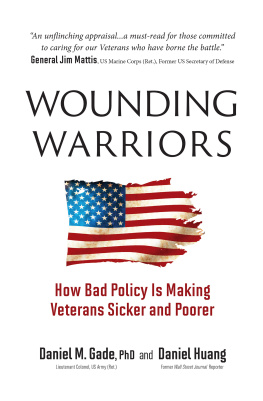FOREWORD
IN THE YEARS FOLLOWING THE WAR IN VIETNAM, the Department of Veterans Affairs (VA) healthcare system was viewed by many as a bleak backwater of inefficiency, indifference, and incompetence. Critics cast the VA as a symbol of ineffective and bloated government bureaucracy, and it became the poster child for those who argued that government can never do anything right. Howeverand remarkably to manythe VAs image began to dramatically change in the late 1990s and continuing into the early 2000s. Among other notable publications, the Wall Street Journal, BusinessWeek, New York Times, Forbes, and Time began applauding the VA for improvements in the quality of its healthcare services, its pioneering use of information technology, and a newfound responsiveness to veterans. Increasingly, the Veterans Healthcare System was touted as a model for twenty-first-century healthcarea model, it was argued, that private-sector hospitals and health plans should emulate. Unfortunately, missteps by the VA in recent years have led some politicians and members of the media to suggest that the VA has returned to its post-Vietnam era state of functioningand that they were right all along about government programs. In this book, Suzanne Gordon highlights why these views miss the mark.
In spite of some now well-described problems, the VA operates one of the nations best healthcare systems. Studies in leading professional journals continue to document that the quality of VA healthcare is equal and often superior to the care provided in the private sector and that most VA users are very satisfied with their care. Of course, just as in the private sector, there are variations in the quality of services provided by individual VA hospitals and across caregivers, and these variations should be addressed.
In addition to providing good healthcare, the VA Healthcare System conducts cutting-edge research, trains more healthcare professionals than any other institution in America, and plays a critical role in responding to the nations public health emergencies. In these and other ways that its critics typically overlook, the VA materially benefits all Americans.
As undersecretary for health in the Department of Veterans Affairs and chief executive officer of the Veterans Healthcare System from 1994 to 1999, I had the privilege of leading a team of highly dedicated professionals in a far-reaching initiative to re-engineer VA healthcare. We sought to transform the Veterans Healthcare System into a high-performing organization. We did this by implementing a focused and meaningful performance management system, decentralizing day-to-day operational decision making, moving to a value-based resource allocation system, nurturing innovation, and modernizing information management, including deploying the most effective electronic health record in the world at the time.
We pushed for legislative changes, which allowed the VA to treat all the health problems a veteran might be experiencingnot just those that were service connectedso that we could put the veteran at the center of the healthcare universe and design robust veteran-centered services rooted on a foundation of primary care. We understood that medical and mental health problems not related to military service inevitability impact a veterans service-connected problems as well as all other aspects of his or her life. We also established important partnerships with private-sector healthcare organizations, partnering with and learning from them, as they did from us. We moved the system from one that provided mostly inpatient hospital care to one that focused increasingly on providing coordinated, community-based ambulatory care. Perhaps most important, we did all we could to support the dedicated VA staff at the frontlines of care.
Since the late 1990s, the VA has been widely recognized as being a pioneer in integrating and coordinating services for veterans, a large number of whom have highly complex medical and psychological conditions caused or exacerbated by military service. Primary carewhich has been integrated with mental health care, as well as with pharmacy, nutrition, social work, housing, and employment serviceshas become the foundation of the VA healthcare system. While still a work in progress, the VA has sought to weave a healing web of interconnected programs and support services because it recognizes that the complex conditions that affect many veterans must be treated in a holistic, whole-person manner, rather than as a collage of disparate clinical conditions. This way of viewing healthcare service delivery is only now beginning to be operationalized in the private sector.
The VA has also become a leading advocate for and innovator in patient safety, patient engagement, and team-based care. VA physicians, nurses, and allied healthcare professionals work together in collaborative and complementary ways to meet the needs of their patients, and they continually seek new and better ways to do so. The VA has funded and supported system-wide deployment of innovative approaches to veteran-centric careinnovations often conceptualized and developed on the frontlines of care delivery. The VA has sought to develop a multilane innovation highway that is facilitated by it being a national system of carein fact, Americas only national healthcare system.
Regrettably, during the past decade or so, the culture of quality improvement and accountability that had taken root in VA healthcare in the late 1990s began to crack and erode. A gradual return to highly centralized control of operational decision making, misguided approaches to performance measurement, growing insularity, and burgeoning bureaucracy all chipped away and undermined the culture of quality that had taken hold in the late 1990s. Too often, VA leaders have lost sight of the sacred mission underlying the Veterans Healthcare System. And while the quality of clinical care generally has remained high, these regressive trends negatively impacted the provision of services in some instances.
VAs organizational retrenchments have prompted some to again call for veterans healthcare to be turned over to the private sector. Fortunately, more knowledgeable and dispassionate persons have spoken out against this idea, understanding that privatizing veterans healthcare would be a grave mistake and would not serve our former warriors well.
Instead of privatizing veterans healthcare, we should focus on fixing VAs problems, many of which also plague private-sector healthcare providers. Indeed, stories reported in newspapers and other media remind us every day of the shortcomings of private-sector healthcare, and especially when it comes to treating mental health problems, coordinating care for complex medical conditions, and treating socioeconomically disadvantaged persons. Clearly, privatizing veterans healthcare offers no panacea.
In this book Suzanne Gordon wisely counsels us that we must view the VAs problems in their historical and cultural context. She reminds us that modern healthcare is extremely complex and that a wide-angle lens should be used to get a complete picture of a healthcare system. For example, consider the issue of wait times in the VA. Without question, the VA has had serious problems with wait times at many of its medical centers in recent years, and unfortunately, it did not appropriately manage these problems. However, wait times are a significant problem in the private sector as well. And when considering wait times, one also should reflect on the quality of care that is being waited for. In this regard I am reminded of the findings of a recent study that some colleagues and I undertook to assess variations in the quality of care for cancer among Californians with different types of health insurance. We found that veterans waited longer for their treatment than patients with other forms of health insurance, but they also had generally better outcomes than comparable patients having other types of health insurance, and their treatment was more likely to be appropriate for their condition. This should not be taken to mean that the VA should ignore its wait time problems. Clearly, the VA needs to see many of its patients more quickly, but the fact that the VAs cancer care outcomes were better, notwithstanding the delays in patients getting care, underscores the importance of getting the right care. As important as wait times are, they should not be the only metric by which a health system is measured.








![Louis Hicks - The Civilian Lives of U.S. Veterans: Issues and Identities [2 volumes]](/uploads/posts/book/133676/thumbs/louis-hicks-the-civilian-lives-of-u-s-veterans.jpg)
